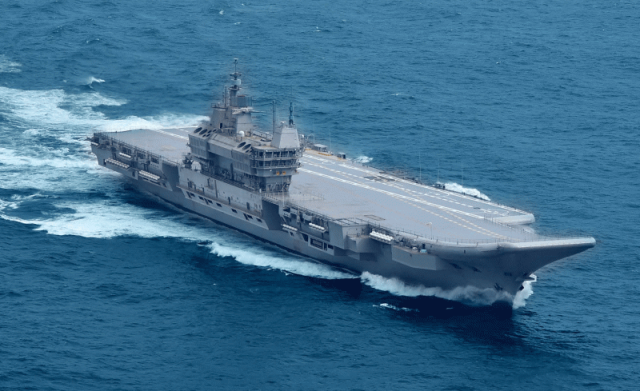The commissioning on September 2, 2022 of the first Indian-built aircraft carrier R 11 Vikrant represents an important and long-awaited step in the development of India's aircraft carrier capabilities. At the same time, this event was a reminder of the limits of these opportunities and the problems of their further expansion, write the staff of the International Institute for Strategic Studies (IISS) Nick Childs and Douglas Barrie.

The first Indian aircraft carrier of national construction R 11 Vikrant at the test stage (c) Cochin ShipyardSize matters
Vikrant was laid back in 2009, but its construction was delayed for various reasons.
Nevertheless, the completion of the project certainly represents a significant achievement of the Indian naval industry, and the aircraft carrier itself is the largest ship built in the country.
Ultimately, its commissioning may be very timely, given the growing concern of New Delhi about the strengthening of China's naval presence in the Indian Ocean. Commentators unequivocally expose this as a justification for the need for a new aircraft carrier.
However, with a full displacement of about 45 thousand tons, Vikrant is an average aircraft carrier by modern standards. This limits the ship's air group to about 30 aircraft and helicopters, which reduces the ability to simultaneously conduct both defensive and offensive air operations.
The new ship joins the Indian Navy to the R 33 Vikramaditya, built in 1987 as the Soviet aircraft carrier "Baku", later renamed "Admiral of the Fleet of the Soviet Union Gorshkov", and in 2013 joined the Indian Navy in a highly modified form. Thus, India today is one of the few countries operating more than one aircraft carrier (the others are China, the United Kingdom and the United States). However, with a similar full displacement of about 45 thousand tons, Vikramaditya's capabilities for placing aircraft are even more limited than those of the new ship.
Both ships are also limited by the fact that they are configured for a shortened takeoff and aerial landing (STOBAR) using springboards instead of a catapult, which limits the range and payload of aircraft operating from their deck. In addition, Vikrant is noticeably constrained by the number of airplane lifts, which further limits the types of aircraft that can be placed in a ship hangar (Vikramaditya suffers from similar limitations).
A fulcrum or a weak point?Another practical limitation at present is the number of carrier-based aircraft actually available to the Indian Navy to equip two ships.
The Indian Navy has 43 MiG-29K fighters divided into two squadrons. Currently, a tender is being held for the purchase of 26 more deck combat aircraft. It involves Boeing F/A-18E/F Super Hornet and Dassault Rafale M aircraft. The experience of operating MiG-29K fighters by the Indian Navy is ambiguous, including in terms of maintenance and combat readiness.
The initial Request for Information (RFI) in the tender for a new carrier-based fighter in 2017 concerned 57 aircraft, but in 2021 this number was reduced as the Indian Navy seems to have revised its medium and long-term procurement strategies. It seems that the MiG-29K fighters will be operated until about 2035, until they are replaced by a new type of aircraft, which has not yet been selected. Representatives of the Indian aircraft industry continue to have hopes for the development of their own carrier-based fighter, despite the initial failure with the marine version of the Tejas light combat aircraft.
What will happen next?The transfer of a new aircraft carrier to the Indian Navy represents a serious investment in the future of India.
Despite the fact that the country has considerable experience in conducting carrier operations using two former British ships (the first Vikrant and Viraat), some observers continue to doubt the need for such capabilities. However, when both of the current aircraft carriers are fully operational, they will potentially significantly increase India's ability to perform both tasks of controlling maritime space and projecting power in the Indian Ocean and beyond. Aircraft carriers also enhance the Indian Navy's ability to operate independently in the world's oceans. Perhaps equally important, the aircraft carriers will increase India's potential contribution to multilateral naval formations with the country's partners, including France, Japan, the United Kingdom and the United States.
Comparing the capabilities of the Indian fleet with the Chinese one, it is worth noting that Beijing already has at its disposal two aircraft carriers with a total displacement of 65-70 thousand tons, made in the STOBAR configuration. In addition, the first aircraft carrier designed for springboard takeoff (CATOBAR) was launched in July. With an estimated total displacement of 85 thousand tons, it is closer to competing with the aircraft carriers of the US Navy in size and capabilities. New ships are expected, which can also be equipped with nuclear power plants, and Beijing is believed to be aiming to build six aircraft carriers by the 2030s.
However, at the moment, Beijing is rather cautiously deploying its aircraft carriers for long-range operations. This may change. Nevertheless, India's new aircraft carriers are likely to strengthen its capabilities to deter a potential enemy, as well as its ability to perform tasks to control maritime space and prohibit access in the Indian Ocean.
The Indian Navy also still harbors ambitions to create its own larger aircraft carrier with a springboard take-off and a full displacement of 65 thousand tons, in order to realize the idea of creating a grouping of three aircraft carriers. The creation of such a new ship is likely to be facilitated by the technological know-how of the United States and the support of other partners, in particular France and the United Kingdom. However, it is unlikely that this will bear fruit earlier than in the next decade. The prospects for the implementation of such a concept are likely to depend on the experience and lessons learned from the operation of the two ships currently available to the Indian Navy, especially the last one commissioned.
